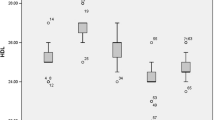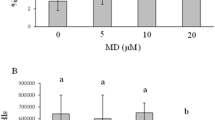Abstract
Exposure to electromagnetic radiation (EMR) is rapidly increasing in everyday environment, consequently conferring potential health effects. Oxidative stress is emerging as a mechanism implicated in pathophysiology and progression of various diseases. To our knowledge, no report has been made on the status of antioxidant redox systems after continuous exposure to radiofrequency radiation emitted from a Wi-Fi access point in animal model so far. Therefore, we aimed to continuously subject rats in the experimental group to radiofrequency (RF) radiation emitted from a commercially available Wi-Fi device. Male Wister rats were exposed to 2.45 GHz RF radiation emitted from a Wi-Fi for 24 h/day for 10 consecutive weeks. In order to assess the change in antioxidant redox system of plasma after continuous exposure to a Wi-Fi device, the total antioxidant capacity of plasma, level of thiobarbituric acid reactive substances, concentration of reduced glutathione (GSH), and activity of different enzymatic antioxidants, e.g., superoxide dismutase [SOD], catalase [CAT], glutathione peroxidase [GSH-Px], and glutathione S-transferase [GST], were measured. In the Wi-Fi exposed group, a significant decrease was detected in total antioxidant capacity of plasma and the activities of several antioxidant enzymes, including CAT, GSH-Px, and SOD (P < 0.05). Meanwhile, the GST activity was significantly increased in this group (P < 0.05). However, no significant changes were found in GSH and TBARS levels following exposure to RF radiation. According to the results, oxidative defense system in rats exposed to Wi-Fi signal was significantly affected compared to the control group. Further studies are needed to better understand the possible biological mechanisms of EMR emitted from Wi-Fi device and relevant outcomes.




Similar content being viewed by others
References
Aebi H (1984) Catalase in vitro. Methods Enzymol 105:121–126
Akdag MZ, Bilgin MH, Dasdag S, Tumer C (2007) Alteration of nitric oxide production in rats exposed to a prolonged, extremely low-frequency magnetic field. Electromagnetic Biology Med 26:99–106
Atasoy HI, Gunal MY, Atasoy P, Elgun S, Bugdayci G (2013) Immunohistopathologic demonstration of deleterious effects on growing rat testes of radiofrequency waves emitted from conventional Wi-Fi devices. J Pediatr Urol 9:223–229
Avendano C, Mata A, Sarmiento CAS, Doncel GF (2012) Use of laptop computers connected to internet through Wi-Fi decreases human sperm motility and increases sperm DNA fragmentation. Fertility Sterility 97 e2:39–45
Benzie IF, Strain JJ (1996) The ferric reducing ability of plasma (FRAP) as a measure of “antioxidant power”: the FRAP assay. Anal Biochem 239:70–76
Brydon L, Petit L, Delagrange P, Strosberg AD, Jockers R (2001) Functional expression of MT2 (Mel1b) melatonin receptors in human PAZ6 adipocytes. Endocrinology 142:4264–4271
Buege JA, Aust SD (1978) Microsomal lipid peroxidation. Methods Enzymol 52:302–310
Celik O, Kahya MC, Naziroglu M (2016) Oxidative stress of brain and liver is increased by Wi-Fi (2.45GHz) exposure of rats during pregnancy and the development of newborns. J Chem Neuroanat 75:134–139
Danielson UH, Mannervik B (1985) Kinetic independence of the subunits of cytosolic glutathione transferase from the rat. Biochem J 231:263–267
Dimbylow P, Findlay R (2010) The effects of body posture, anatomy, age and pregnancy on the calculation of induced current densities at 50 Hz. Radiat Prot Dosim 139:532–538
Elferchichi M, Mercier J, Coisy-Quivy M, Metz L, Lajoix AD, Gross R, Belguith H, Abdelmelek H, Sakly M, Lambert K (2010) Effects of exposure to a 128-mT static magnetic field on glucose and lipid metabolism in serum and skeletal muscle of rats. Arch Med Res 41:309–314
Ellman GL (1959) Tissue sulfhydryl groups. Arch Biochem Biophys 82:70–77
Ghodbane S, Amara S, Garrel C, Arnaud J, Ducros V, Favier A, Sakly M, Abdelmelek H (2011) Selenium supplementation ameliorates static magnetic field-induced disorders in antioxidant status in rat tissues. Environ Toxicol Pharmacol 31:100–106
Giannopolitis CN, Ries SK (1977) Superoxide dismutases: II. Purification and quantitative relationship with water-soluble protein in seedlings. Plant Physiol 59:315–318
Goel A, Dani V, Dhawan D (2005) Protective effects of zinc on lipid peroxidation, antioxidant enzymes and hepatic histoarchitecture in chlorpyrifos-induced toxicity. Chem Biol Interact 156:131–140
Gumral N, Naziroglu M, Koyu A, Ongel K, Celik O, Saygin M, Kahriman M, Caliskan S, Kayan M, Gencel O (2009) Effects of selenium and L-carnitine on oxidative stress in blood of rat induced by 2.45-GHz radiation from wireless devices. Biol Trace Elem Res 132:153–163
Gumral N, Saygin M, Asci H, Uguz AC, Celik O, Doguc DK, Savas HB, Comlekci S (2016) The effects of electromagnetic radiation (2450 MHz wireless devices) on the heart and blood tissue: role of melatonin. Bratislavske Lekarske Listy 117:665–671
Gürler HŞ, Bilgici B, Akar AK, Tomak L, Bedir A (2014) Increased DNA oxidation (8-OHdG) and protein oxidation (AOPP) by low level electromagnetic field (2.45 GHz) in rat brain and protective effect of garlic. Int J Radiat Biol 90:892–896
Habig WH, Pabst MJ, Jakoby WB (1974) Glutathione S-transferases. The first enzymatic step in mercapturic acid formation. J Biological Chem 249:7130–7139
Hayes JD, LI ML (1999) Glutathione and glutathione-dependent enzymes represent a co-ordinately regulated defence against oxidative stress. Free Radic Res 31:273–300
Klaunig JE, Kamendulis LM, Hocevar BA (2010) Oxidative stress and oxidative damage in carcinogenesis. Toxicol Pathol 38:96–109
Kono Y, Fridovich I (1982) Superoxide radical inhibits catalase. J Biol Chem 257:5751–5754
Li H-W, Yao K, Jin H-Y, Sun L-X, Lu D-Q, Yu Y-B (2007) Proteomic analysis of human lens epithelial cells exposed to microwaves. Jpn J Ophthalmol 51:412–416
Mansour SA, Mossa A-TH (2009) Lipid peroxidation and oxidative stress in rat erythrocytes induced by chlorpyrifos and the protective effect of zinc. Pestic Biochem Physiol 93:34–39
Nazıroğlu M, Yüksel M, Köse SA, Özkaya MO (2013) Recent reports of Wi-Fi and mobile phone-induced radiation on oxidative stress and reproductive signaling pathways in females and males. J Membr Biol 246:869–875
Neefjes V, Evelo C, Baars L, Blanco C (1999) Erythrocyte glutathione S transferase as a marker of oxidative stress at birth. Arch Dis Child Fetal Neonatal Ed 81:F130–F133
Ongel K, Gumral N, Ozguner F (2009) The potential effects of electromagnetic field: a review. Cell Membranes Free Radical Res 1:85–89
Özorak A, Nazıroğlu M, Çelik Ö, Yüksel M, Özçelik D, Özkaya MO, Çetin H, Kahya MC, Kose SA (2013) Wi-Fi (2.45 GHz)-and mobile phone (900 and 1800 MHz)-induced risks on oxidative stress and elements in kidney and testis of rats during pregnancy and the development of offspring. Biol Trace Elem Res 156:221–229
Pham-Huy LA, He H, Pham-Huy C (2008) Free radicals, antioxidants in disease and health. Int J Biomed Sci 4:89–96
Pigeolet E, Corbisier P, Houbion A, Lambert D, Michiels C, Raes M, Zachary M-D, Remacle J (1990) Glutathione peroxidase, superoxide dismutase, and catalase inactivation by peroxides and oxygen derived free radicals. Mech Ageing Dev 51:283–297
Repacholi MH, Greenebaum B (1999) Interaction of static and extremely low frequency electric and magnetic fields with living systems: health effects and research needs. Bioelectromagnetics 20:133–160
Salah MB, Abdelmelek H, Abderraba M (2013) Effects of olive leave extract on metabolic disorders and oxidative stress induced by 2.45 GHz WIFI signals. Environ Toxicol Pharmacol 36:826–834
Sangun O, Dundar B, Darici H, Comlekci S, Doguc DK, Celik S (2015) The effects of long-term exposure to a 2450 MHz electromagnetic field on growth and pubertal development in female Wistar rats. Electromagnetic Biology Medicine 34:63–71
Saygin M, Asci H, Ozmen O, Cankara FN, Dincoglu D, Ilhan I (2015): Impact of 2.45 GHz microwave radiation on the testicular inflammatory pathway biomarkers in young rats: the role of gallic acid. Environmental toxicology
Scandalios J (2005) Oxidative stress: molecular perception and transduction of signals triggering antioxidant gene defenses. Braz J Med Biol Res 38:995–1014
Sureda A, Tauler P, Aguiló A, Cases N, Fuentespina E, Córdova A, Tur JA, Pons A (2005) Relation between oxidative stress markers and antioxidant endogenous defences during exhaustive exercise. Free Radic Res 39:1317–1324
Vignera S, Condorelli RA, Vicari E, D'Agata R, Calogero AE (2012) Effects of the exposure to mobile phones on male reproduction: a review of the literature. J Androl 33:350–356
Wendel A (1981) Glutathione peroxidase. Methods Enzymol 77:325–333
Yang Y, Cheng J-Z, Singhal SS, Saini M, Pandya U, Awasthi S, Awasthi YC (2001) Role of glutathione S-transferases in protection against lipid peroxidation overexpression of HGSTA2-2 in K562 cells protects against hydrogen peroxide-induced apoptosis and inhibits JNK and caspase 3 activation. J Biol Chem 276:19220–19230
Yuksel M, Naziroglu M, Ozkaya MO (2016) Long-term exposure to electromagnetic radiation from mobile phones and Wi-Fi devices decreases plasma prolactin, progesterone, and estrogen levels but increases uterine oxidative stress in pregnant rats and their offspring. Endocrine 52:352–362
Zotti-Martelli L, Peccatori M, Scarpato R, Migliore L (2000) Induction of micronuclei in human lymphocytes exposed in vitro to microwave radiation. Mutation Res/Genetic Toxicology Environ Mutagenesis 472:51–58
Author information
Authors and Affiliations
Corresponding author
Additional information
Responsible editor: Philippe Garrigues
Rights and permissions
About this article
Cite this article
Kamali, K., Taravati, A., Sayyadi, S. et al. Evidence of oxidative stress after continuous exposure to Wi-Fi radiation in rat model. Environ Sci Pollut Res 25, 35396–35403 (2018). https://doi.org/10.1007/s11356-018-3482-0
Received:
Accepted:
Published:
Issue Date:
DOI: https://doi.org/10.1007/s11356-018-3482-0




